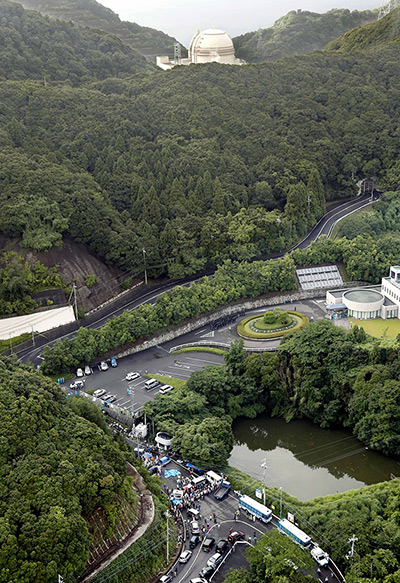So, as far as Kansai Electric Power Company and the Nuclear Regulatory Authority are concerned, an accident at Ooi Nuclear Power Plant that could involve station blackout, multiple core melt, severe damages to reactor buildings and turbine buildings not to mention damaged water intake for the secondary cooling systems can be dealt with as long as KEPCO keeps a room next to the central control room available which will serve as the emergency response headquarters.
RRRIIIGGGHHHTTT....
Also recall that the main access route to Ooi Nuke Plant, the only nuclear power plant in operation in Japan right now, is via the tunnel under the mountains. When KEPCO forced the restart, the company sent employees on a boat to avoid the protesters on land. Good luck with that after an earthquake and tsunami.
From Jiji Tsushin (6/11/2013):
代替対策所に異論出ず=大飯原発の新基準確認会合-規制委
No objection on alternative emergency response HQ at an NRA meeting to confirm whether Ooi Nuke Plant meets the new safety standards
原子力規制委員会は11日、国内の原発で唯一運転中の関西電力大飯原発3、4号機(福井県おおい町)が新規制基準案に適合しているか確認する会合を開いた。メルトダウン(炉心溶融)など大事故が起きた場合の緊急時対策所が焦点だったが、関電は同原発1、2号機の中央制御室横にある部屋を代替施設にすると説明。大きな異論は出なかった。
Nuclear Regulatory Authority held a meeting on June 11 to confirm whether Reactors 3 and 4 at Ooi Nuclear Power Plant by KEPCO (Ooi-cho, Fukui Prefecture), the only operating nuclear power plant in Japan, meet the new regulatory standards. The focus was on the emergency response headquarters in a major accident that would involve meltdown (core melt). KEPCO explained that a room located next to the central control room for Reactors 1 and 2 at Ooi Nuke Plant would serve as the alternative emergency response headquarters, and there was no major objection [from NRA].
規制委はまた、15日に大飯原発の現地調査を行うことを決定。結果を踏まえ、今月中にも運転継続の可否を判断する。安全上重大な問題がなければ、9月の定期点検まで運転を認める方針。
NRA also decided to conduct a survey of the plant on June 15, and it will decide whether the plant should continue to operate by the end of this month. If there is no significant safety problem, NRA is going to approve continued operation until the scheduled maintenance in September.
Reactors 1 and 2 at Ooi Nuclear Power Plant have been in the scheduled maintenance.
TEPCO had the multi-story Anti-Seismic Building at Fukushima I Nuke Plant that was completed just in time, and it has been used as the emergency response headquarters. KEPCO says a room next to the control room will be sufficient, and no one at NRA thinks it is not.
The NRA doesn't seem to have any problem with KEPCO's estimate either that in case of an earthquake caused by a 90-kilometer-long active fault in Wakasa Bay a 3-meter-high tsunami (max) will hit the water intake at the plant, which is located at 9.7 meters above the sea level.
Where have we seen the similar numbers before? And what has happened to the nuclear plant?
Dismissing its own internal estimates (10 to 15 meters), TEPCO settled for the max 5.7-meter tsunami in case of a large earthquake of Magnitude 7.9. It was 15-meter tsunami/run-up, and M.9.0 earthquake.
From Jiji Tsushin (6/10/2013):
地震、津波の確認ほぼ終了=大飯原発の新基準評価-規制委
Study of earthquake, tsunami almost complete, in evaluation of Ooi Nuke Plant on the new regulatory standards, says NRA
国内の原発で唯一運転中の関西電力大飯原発3、4号機(福井県おおい町)が新規制基準案にどの程度適合しているかを判断する原子力規制委員会の評価会合が10日開かれ、地震と津波に関する確認作業をほぼ終えた。規制委は施設の安全対策などの確認を進め、月内にも運転継続の可否を判断する。
Nuclear Regulatory Authority held a meeting on June 10 to evaluate whether Reactors 3 and 4 at Ooi Nuclear Power Plant meets the new regulatory standards. The plant, operated by KEPCO, is the only nuclear power plant operating in Japan. NRA will continue to confirm the safety measures at the plant, and will decide whether the plant should continue to operate by the end of this month.
関電は10日の会合で、大飯原発がある若狭湾で長さ約90キロの断層が動き、海底で地滑りが発生したと仮定した場合、3、4号機の取水口付近に最大約3メートルの津波が到達するとのデータを示した。3、4号機の敷地の高さは海抜9.7メートルだが、規制委は取水口などから津波が流入した場合の影響について、施設面の評価を求める。
In the June 10 meeting, KEPCO showed the data that says a tsunami with the maximum height of 3 meters would reach the water intake for Reactors 3 and 4 if they assume the 90-kilometer-long fault moves in Wakasa Bay, where Ooi Nuke Plant is located, and submarine landslide occurs. The site elevation at Reactors 3 and 4 is 9.7 meters from the sea level, but NRA will ask for evaluation of the effect on the facilities if the tsunami water flows in from the water intake.
Uh... How about some evaluation if the tsunami water is much, much higher than the operator anticipates, like it happened in Fukushima two years ago?
It looks more and more like NRA is another NISA after all, agency to enable electric power companies to operate nuclear power plants with minimum oversight.
In other words, Japan has fully recovered from the biggest nuclear accident in the nation's history.




 Tokyo Time
Tokyo Time
![[Most Recent Quotes from www.kitco.com]](http://www.kitconet.com/charts/metals/gold/t24_au_en_usoz_2.gif)


5 comments:
See no danger, hear no danger, talk no danger. You can find those monkeys at a temple in Nara and at the NRA
I thought there had to be an alternate control room a few kilometres away from the plant (5km?10km?) *according to NRA own rules*. What happened??
There was an alternate control room for Fukushima Daiichi too, so to speak... it was without power and without air filters so it was there just to pretend they had one but still there was an obligation to have one... and now Kepco does not even have to pretend?
Beppe
Alternate control room – cardboard cubicle in the corner of the regular control room?
Nobody ever sees problems until it's too late.
It's ridiculous how many times I've tried to warn people to save them from all kinds of trouble and they just didn't want to listen.
Humans just want to learn things the hard way.
@10:27 maybe the urge to learn by direct experience is real for some individuals, however the story is different for large corporations: they *choose* to ignore the danger because they expect to be able to externalize the costs.
Richard F. head of a large investment bank in the US was shocked not to have been rescued by the taxpayer, Tokyo Electric was saved by the taxpayer, Thyssen-Krupp in Italy run an old steel factoty until it killed a few, then shut it down. The examples are countless.
Beppe
Post a Comment